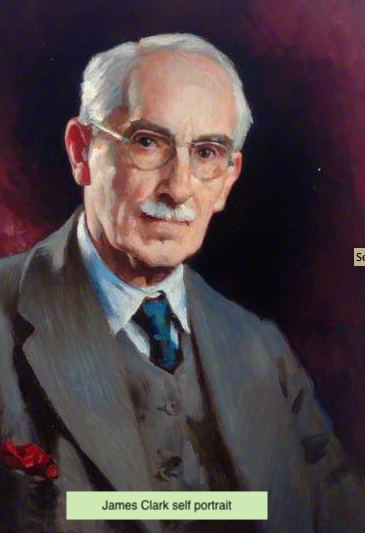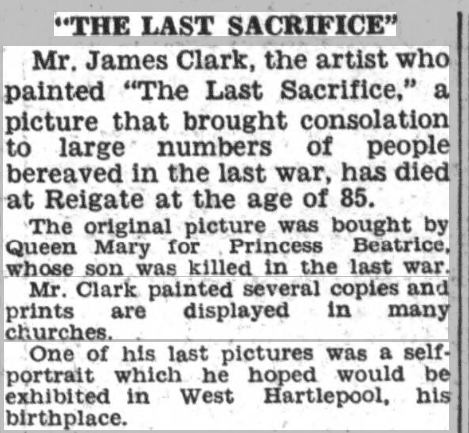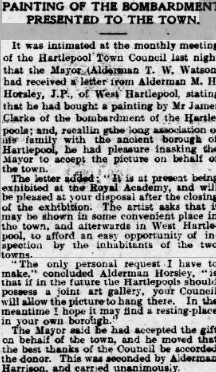James Clark R.I. Artist
The family traces back to Morpeth with Thomas Bittlestone born 1620.
Hannah married George McKay, a ships carpenter, born around 1805, on 1st May 1825.
I have never been able to find a death for George.
He may have been lost at sea.
They had just one child, James McKay. (see the family of James McKay and Mary Ann Scott)
Hannah next married James Clark on 5th May 1833.
They had 2 sons - William born 1835 and Joseph born 1837.
William Clark was a prosperous pawnbroker who lived with his wife, Ellen nee Wilkinson, at Sunny Side House, Stranton, Durham.
His servant in 1871 was Elizabeth McKay aged 20. No doubt a relative of his mothers first husband.
William had 6 children -
James, born 1857; Ellen born 1865; William born 1866; Hannah born 1868; Wilkinson born 1869; Joseph born 1871 and Elizabeth born 1872.
Their eldest son, James Clark, was to grow up to become a Professional Artist of some renown.
James Clark R.I. rose to prominence in 1914 when his painting entitled The Great Sacrifice was reproduced as the souvenir print issued by The Graphic illustrated newspaper with its Christmas number.
The painting depicted a young soldier lying dead on the battlefield beneath a vision of Christ on the Cross. It had an immediate appeal to many, and prints were snapped up by churches, schools, and mission halls. One reviewer stated that the print had "turned railway bookstalls into wayside shrines." Framed copies were hung in churches next to Rolls of Honour, and clergymen gave sermons on the theme of the painting. The original oil painting was bought by Queen Mary, wife of George V but several other copies were made including one commissioned by Queen Alexandra. Queen Mary gave the picture to Princess Beatrice, the last surviving child of Queen Victoria. In memory of her son, Prince Maurice Of Battenburg who was killed in action at Ypres, she in turn presented it to St Mildred's Church, Whippingham, near Osborne House on the Isle Of Wight, where it can still be seen hanging above the rectors desk.
So successful was the print that the Graphic commissioned Clark to paint a companion piece and in April 1917 a new print entitled The Great Reward was issued.
Clark designed a number of war memorials and his painting was the basis for several memorial stained glass windows in churches. He executed the scheme of wall paintings in the nave of Holy Trinity Church, Casterton, Cumbria, between 1905 and 1912.
He was made a member of the Royal Institute of Painters In Watercolours and regularly exhibited at the Royal Academy.
James Clark married Elizabeth Hunter at Stranton Parish Church in 1882.
By 1891 the family was living at Victoria Grove, Chelsea and James was a professional artist.
His father was still living at Sunny Side House with his two daughters assisting in his pawnbroking business.
In 1901 they were still at Victoria Grove and his daughter Lilian was an Art Student.
By 1911 James' family had moved to 10 Netherton Grove, Chelsea and his daughter Ruth was a Gymnastics Instructor.
At some time they moved to Reigate in Surrey.
In 1942 James and Elizabeth celebrated their diamond wedding anniversary.
James died at the age of 85 in Reigate.
Elizabeth died in 1953.
James and Elizabeth had 6 children-
Lilian born 1885; Ruth born 1887; Percy William 1889-1943; James Hunter Colville 1891-1931; Ellen born 1895 and John Cosmo 1897-1967.
James Hunter Colville Clark was in the Royal Navy aboard HMS Tara in 1915.
He married Doris Briscoe in 1916. They were divorced in 1928.
He shot himself on a golf course in Simonstown South Africa in 1931, aged 40.
Percy William had a distinguished military career-
John Cosmo Clark also had a successful career -
1912 - aged 15 - Entered Goldsmiths' College, School of Art
1914 - Enlisted London Regiment
1915 - Commisioned Middlesex Regiment Captain
1918 - Awarded Military Cross
1919 - Student at Royal Academy Schools of Art, Awarded RA Gold medal in Painting and Edward Stott Travelling Scholarship.
1921 - Student at Academie Julian, Paris, also in Italy and Canada
1922 - Appointed visiting teacher of life painting, Camberwell Schools of Arts & Crafts
1924 - Married Jean Manson Wymer
1928 - Lived and worked in New York
1938 - Appointed Head of Hackney School of Art
1939 - Appointed to Air Ministry, Camouflage Directorate.
1942 - Appointed Director Rural Industries Bureau.
1946 - Elected Member New English Art Club
1948 - Awarded silver medal, Royal Society of Arts
1949 - Elected associate Royal Academy of Arts
1955 - Awarded CBE
1958 - Elected Full Member of Royal Academy of Arts
1967 - Died at 16 St. Peter's Square, Hammersmith








